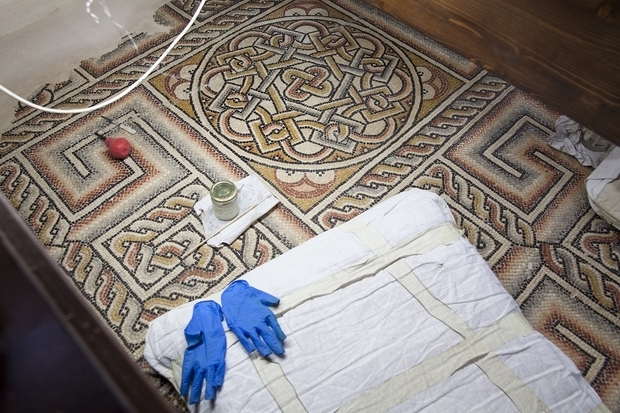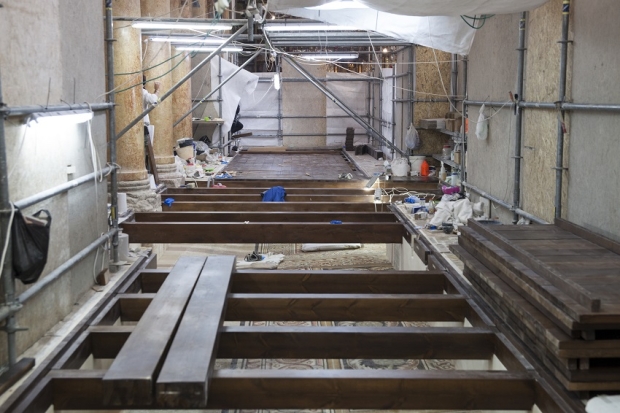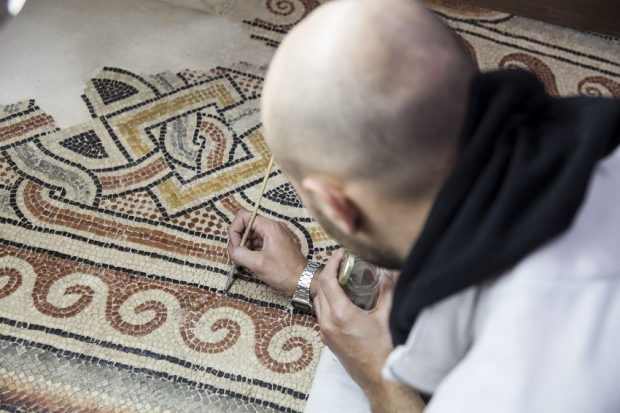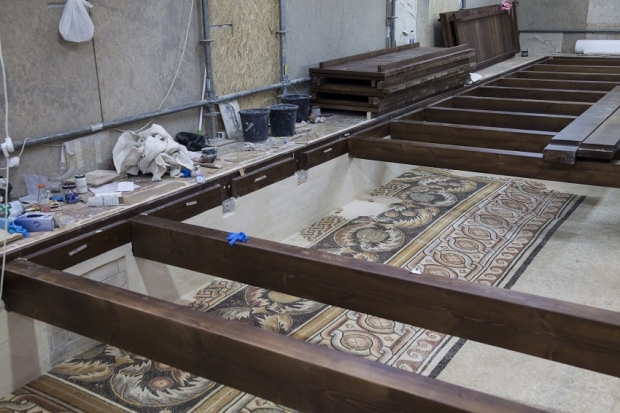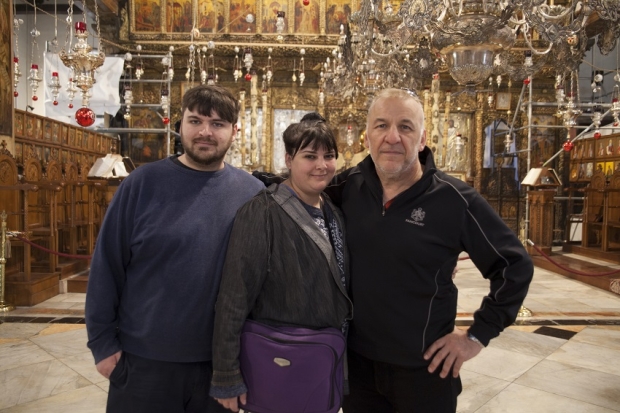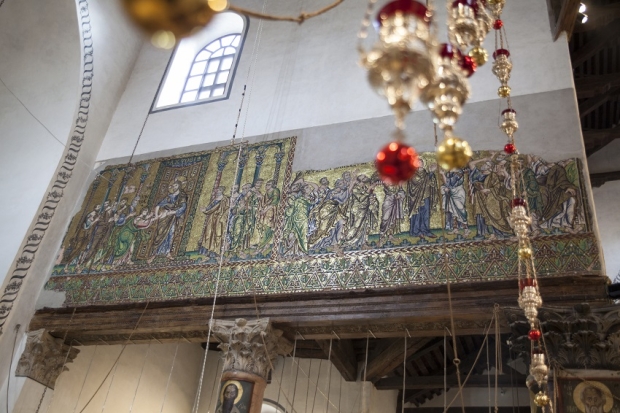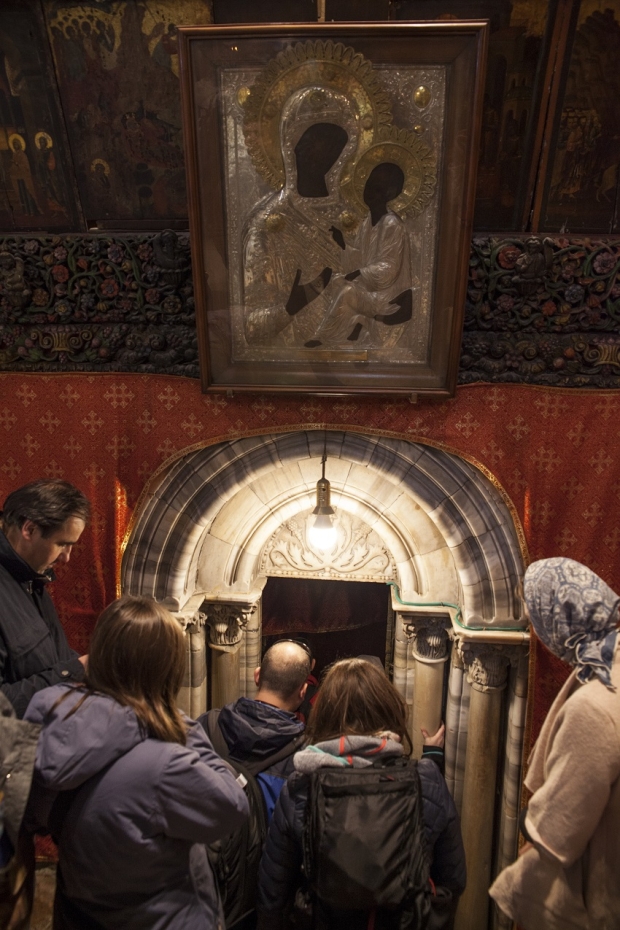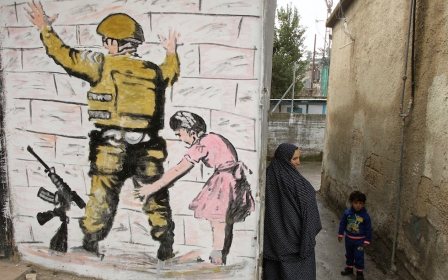Early Christian mosaics at Bethlehem's Church of Nativity revealed
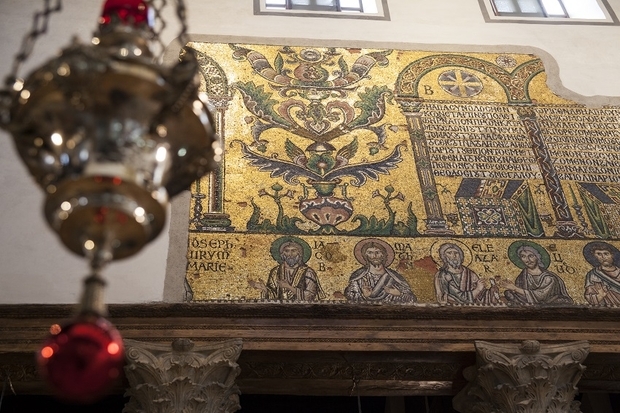
BETHLEHEM, Palestine - These are floors where pilgrims and churchgoers have stood and worshipped in the birthplace of Jesus for millennia.
In the Church of the Nativity, burning oil lamps infuse the air while the hushed voices of international pilgrims are heard.
Some visitors kiss the glistening star in the grotto of the church, where according to tradition Jesus was born.
In the week of Christmas alone, 100,000 pilgrims and tourists are expected to visit Bethlehem in the occupied West Bank, to celebrate the birth of Christ in the Holy Land.
Now, for the first time in centuries, the intricate artwork that lay buried and hidden beneath the church floor can be seen again.
After years of careful work, the beauty of the long-buried floor mosaics dating back to the origins of Christianity has been restored to a condition close to that seen 16 centuries ago.
It is the first renovation of the church undertaken by the Palestinian Authority (PA), beginning one year after the UN's cultural agency, UNESCO, added the Church of the Nativity and its pilgrimage route to the list of World Heritage Sites.
Local representatives of the three Christian denominations - Greek Orthodox, Roman Catholic and Armenian Apostolic - that share the administration of the church oversee the renovations undertaken by the Italian company Piacenti, as contracted by the PA.
When I am here, I feel the peace and love
- Father Issa Thaljieh
"It's important to keep this church as perfect as it could be. People, especially in Christmas time, look at the Church of Nativity," Father Thaljieh told MEE.
The floor mosaics, which lie about 30 centimetres below the current church floor level, make up decorative "carpets" dating back to when the church was built on the site by the Roman emperor Constantine in the fourth century.
Marcello Piacenti, the production manager, explained that his team is dedicated to protecting the historical work of art. A protection solvent is being applied to each tiny mosaic tile by hand and with equally small paintbrushes.
As the lower ground mosaics are finished, the church leaders have instructed Piacenti to cover them with wooden floor panels that are easily lifted to show them to tourists and pilgrims during guided tours but prevent the art from being walked on.
Among those visiting the Church of the Nativity in the lead up to Christmas are members of the Matthews family from South Africa, who gave their appreciation of the newly restored mosaics.
"It's awe inspiring. It's a lot to take in. It's beautiful," Nicolette Matthews,17, rounded off what her father had said.
In total, the church renovations will cost upwards of $17m, funded in part by the Palestinian Authority in addition to money collected by church groups around the world, particularly in Brazil and Italy.
Five years work
The church was destroyed in a Samaritan revolt in 529 and rebuilt in 565. The first and most important step in the work started five years ago: the roof and windows had to be fixed in order to make the church waterproof.
"The water from winter rain would come inside and destroy the walls and mosaics," Father Thaljieh said.
It's awe-inspiring. It's a lot to take in. It's beautiful
- Nicolette Matthews, tourist
Not only was their preservation threatened by leaking rainwater running down the walls, but the years of constant oil-lamp use also left the predominately glistening gold tiles discoloured.
"Some [wall] mosaics you could barely see because it was full of black soot," Father Thaljieh said.
As Father Thaljieh walked around the church, he pointed to depictions of Jesus appearing to the apostles after he was crucified, his accession to heaven and Palm Sunday, commemorating Jesus Christ's triumphant entry into Jerusalem five days before his crucifixion.
"Some of them have missing pieces. The entrance hall used to be completely covered in mosaics, but a lot of it was destroyed by the rain."
Praying for peace and love
Father Thaljieh was born in Bethlehem and ordained as a priest in the Church of the Nativity. Now aged 36, he feels a special connection to the sacred site.
Some of them have missing pieces. The entrance hall used to be completely covered in mosaics, but a lot of it was destroyed by the rain
- Father Issa Thaljieh
As on every Christmas, midnight mass is held in the Church of the Nativity by the Latin Patriarch of Jerusalem.
"This year we pray for justice, love and peace and for people to be united because the whole world is being divided at the moment," Father Thaljieh said.
Last year in the weeks leading to Christmas, US President Donald Trump announced his country's recognition of Jerusalem as the capital of Israel, enraging Arab countries and provoking fatal clashes between Palestinians and the Israeli army.
"Trump damaged the season last year when he gave his statement, but we hope this year life will be normal and people will be happy to come and visit the city," Salman told MEE.
He said precise figures of visitors for 2018 will be released by the end of the year.
With the recent deaths of Palestinians and Israeli soldiers in a spate of attacks, the West Bank has seen an increased Israeli military presence and subsequent security checks throughout the past week.
"Definitely any military action or attack affects tourism in the area in general," Qumsiyeh said. "I have been in contact with the hotel association and tourism companies; until now we haven't receive any cancellations."
Qumsiyeh and the city of Bethlehem alike continue to hope for a peaceful Christmas and that their message of love and peace spreads out from the church.
This article is available in French on Middle East Eye French edition.
New MEE newsletter: Jerusalem Dispatch
Sign up to get the latest insights and analysis on Israel-Palestine, alongside Turkey Unpacked and other MEE newsletters
Middle East Eye delivers independent and unrivalled coverage and analysis of the Middle East, North Africa and beyond. To learn more about republishing this content and the associated fees, please fill out this form. More about MEE can be found here.


